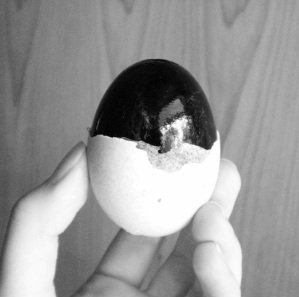
China is a mysterious country with its food being the very embodiment of the mystery. In here, each meal may turn out to be an adventure. Imagine. Your friend has just invited you for lunch. She’s in the middle of cooking. Unexpectedly she’s asking you for help. You’ve just came to China. You now nothing about Chinese cuisine but with a straight face you’re saying “Sure. How can I help?”. She’s giving you 3 eggs and asking “Peel them, please”. Relief. It doesn’t seem to be something tricky. You can do that much. You’ve done that many times before. You start peeling the egg and then…
| “What the hell…” is slipping unconsciously from your mouth. Instead of expected white boiled egg you’re seeing something that resembles black, semi-transparent jelly. You’re turning pale and with the greatest amount of eloquence you can afford yourself at the moment, you’re asking your friend “aaaaaaaaa…. What’s that?!”. She’s checking the name in the dictionary “A hundred-year egg”. You’re turning even paler. “Seriously?!” She doesn’t appear to understand why you’re so agitated. She’s looking at the dictionary once again and a glimmer of understanding is appearing on her face. “No, no. This egg doesn’t really have 100 years. It’s just a name”. You’ve remembered how to breathe once again. You’ve learned the name. It didn’t solve the mystery though. After further questioning your friend and turning to internet resources you can finally say what THAT really is. 松花蛋 sōnghuādàn [en. a hundred-year egg] is a duck’s egg preserved for several weeks (or months) in a mixture of clay, ash, salt, quicklime, and rice hulls (doesn’t sound very appetizing right?). Apparently introducing hydroxide ions (from quicklime) and sodium (from salt) into the egg, causes a curing process (breakdown of proteins and fats to smaller compounds). |
What’s the result?
The white turns to black (or dark brown), semi-transparent jelly (as you’ve spotted before). The yolk becomes creamy and grey. Whole egg gives off an odor of sulfur and ammonia – by-products of the protein breakdown process (in other words it stinks). The smell isn’t intensive though.
How to eat it?
Simple. Peel the egg. Cut in to pieces. Add some soy sauce and it’s done. Some people add this egg to congee.
How does it taste?
Not as bad as you imagine. It’s quite tasty actually (especially with soy sauce). It’s mild and salty with funny aftertaste (slightly resembling a ripened cheese). Try yourself. You can find it in every supermarket in China. It's quite cheap to it.
Bon appetit!
The white turns to black (or dark brown), semi-transparent jelly (as you’ve spotted before). The yolk becomes creamy and grey. Whole egg gives off an odor of sulfur and ammonia – by-products of the protein breakdown process (in other words it stinks). The smell isn’t intensive though.
How to eat it?
Simple. Peel the egg. Cut in to pieces. Add some soy sauce and it’s done. Some people add this egg to congee.
How does it taste?
Not as bad as you imagine. It’s quite tasty actually (especially with soy sauce). It’s mild and salty with funny aftertaste (slightly resembling a ripened cheese). Try yourself. You can find it in every supermarket in China. It's quite cheap to it.
Bon appetit!

 RSS Feed
RSS Feed

